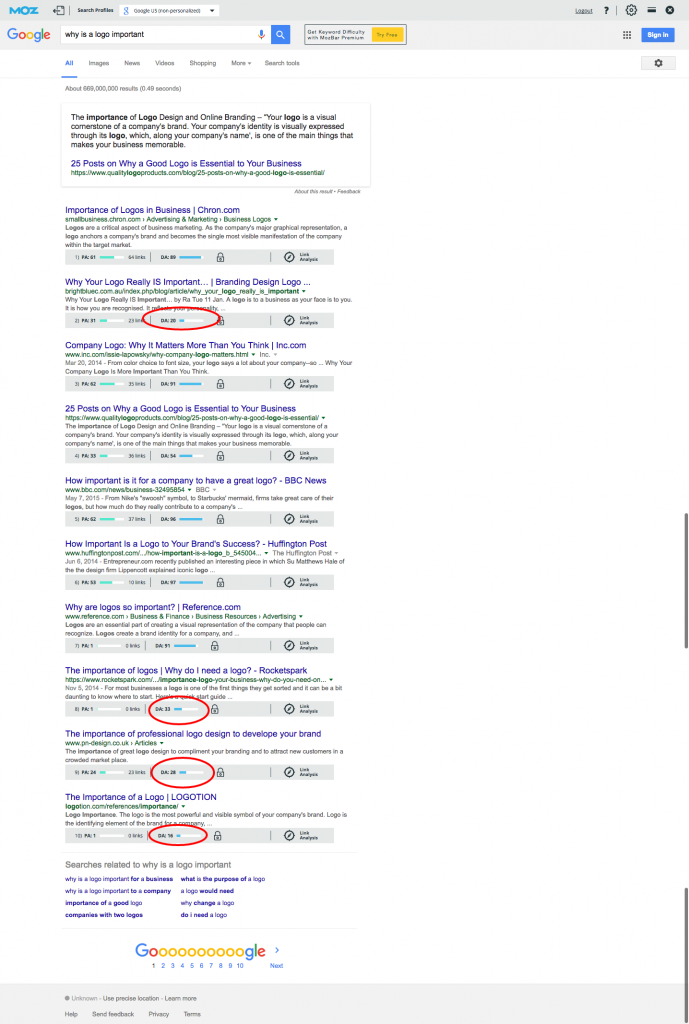How to get freelance clients with content marketing & SEO
Getting clients can be a tough hustle for freelancers, especially when you're starting out. Building your reputation and authority doesn't come easy.
Of course, there are lots of ways to find new contracts. But I believe freelancers should strongly consider experimenting with two underrated business development activities: content marketing & search engine optimization (SEO).
I've already discussed why content marketing is a smart acquisition channel for modern businesses on my personal blog. This brought in a few random requests for content gigs. Then it struck me: if I was a freelancer, I could definitely use content and SEO to find client work.
So I decided to put myself in the shoes of a freelancer and show you how you could use these techniques to get freelance clients. I'll walk you through a simple process for researching, creating and promoting a valuable, search-engine optimized article to bring in leads.
1. Identify a problem your freelance clients face
You'll need to spot the right pain to ease through your content efforts. What you want to do is offer value to potential clients, and prove your expertise while doing so.
So think for a second: what kind of recurring problems do your target customers experience? Maybe they're struggling with their visual branding, or can't make their marketing message resonate. Maybe they're producing low-quality videos harming their brand, or can't manage their SMB's finances.
Identify the right problem, and make it your article's focus.
Let's say you're a graphic designer. Many gigs you do revolve around logo designs for small businesses. As a professional, you know how important a logo is to a brand's success. And you can damn sure tell people why it's important. So you decide to make this the topic of your article.
Now, let's try to match your topic with popular search queries on Google.
2. Target a keyword ranking opportunity for your content
Your goal is to find a mid to long tail keyword (3-6 words) to target.
A head keyword (1-2 words) like logo design sure has lots of research volume. But it's a vague research term that doesn't narrow the search intentions of the user. And ranking for such a competitive keyword is going to be quite difficult.
So we're going to start small. We're going to use a handy little tool called Keyword Tool. Note: Keyword Tool doesn't offer a free trial. However, you can sign up and use the software for 30 days and cancel + get refunded for your first month at any time.
Enter a generic formulation of your topic, like logo importance, and see the keyword suggestions you get. Try to spot longer keywords with decent amounts of search volume (>100). You can also use the Questions tab to see potential formulations of your keyword. Iterate on your searches a few times using different variations of your core keyword. Then, identify 2-3 possible targets. Here, we could list:
- "why is a logo important"—110 monthly searches
- "importance of logo design"—110 monthly searches
- "importance of logo in branding"—50 monthly searches



Our third target here has 2x less traffic than the others; let's put it aside.
Now, what you need to do is get an overview of the competition. In other words: what content is already ranking for your keywords on the first page results? Do you have a shot at ranking your content there? So let's find out.
First, you'll need to install the MozBar extension tool. This will show you the authority of the pages ranking for your keyword on the first page. Head to Google in your browser in incognito mode to wipe personalization and history from your search results (make sure you've enabled the extension in incognito mode in your browser settings). Activate the MozBar in your extension tabs.
Now, search for your different target keywords. Try to see if at least 3-4 sites on the first page have Domain Authority (DA) lesser than 30-40. Here, the "why is a logo important" variation of our keyword had more vulnerable spots.

The quality of your content is more important than the authority of the site on which you're publishing it. Still, site authority weighs a lot in search engine rankings, and gives you a good idea of what chances you'll get. You can slightly overlook this part of the process if you choose to publish on an already authoritative website. We'll discuss this later.
3. Craft your SEO-optimized content piece
Now that you've identified both a valuable topic and targeted a keyword, it's time to craft your content.
Unfortunately, there is no miracle recipe here: you'll just have to write the thing!
Still, there are a few tips that can help you produce quality content:
- Structure and segment your ideas in a clear outline (title, subtitles, key points, etc.)
- Find or create your visual assets (images, screenshots, videos, etc.) and position them in your outline
- Keep in mind the reader's search intent and try to point towards other relevant resources
- Insert compelling call-to-actions to foster conversions (contact you, check out your portfolio, calculate a contract's cost, etc.)
If you'd like to improve your writing skills, read this post by Gregory Ciotti, and his own blog. He knows what's up when it comes to copywriting and content.
Once you've written your content, you'll need to make sure it's optimized for search engines. We wouldn't want these traffic-generating Google rankings slipping through your fingers, right? Here's a handy list to make sure your content pleases good ol' Google:
- Include keyword near the beginning of page title tag
- Use modifiers around keywords in title tag (guide, how-to, top, etc.)
- Keep page URL short and include keyword
- Include keyword or a synonym in page header tag (H1)
- Include keyword in first 100 words
- Include at least one multimedia (image, video, infographic) in content
- Include external links to at least 2 authoritative sources
- Enable social sharing on your page
- Include internal links to at least 2 other relevant and popular content on your site
- Include keyword variations in sub-title tags (H2 & H3)
- Add LSI keywords throughout content
- Define images ALT tags with explicit keywords when relevant
- Include keyword + clear call-to-action in content meta description
- Create, if possible, long-form content (>1500 words)
Note: the list above is mostly based off Brian Dean's SEO optimization checklist. If some technical terms seem obscure, just follow the resources links I attached to them. :)
4. Choose where you'll publish your content
This part will influence both your rankings and the initial amount of eyeballs stumbling upon your content. You pretty much have three options here:
1. Publish the article on your own freelancer site
Pros
- Reap all the SEO benefits—the organic traffic from Google will come to your site.
- Control the environment where content is read—better conversion rate with strong CTAs, personalized offers, timely pop-ups, retargeting, etc.
Cons
- If you just launched your site, ranking on Google will be harder due to a lack of domain authority and backlinks.
- Your personal audience will be significantly smaller than options 2 & 3. Less initial eyeballs.
2. Publish it as a guest post on a popular site for your freelance clients
Pros
- Highly increase your chances of ranking on Google with a high-authority site.
- Get your content in front of an already well-built, targeted audience.
- Improve your reputation and expertise by contributing content to a quality site.
Cons
- Content is read in an environment you have little control over (for branding and on-site marketing).
- If your content ranks on Google, the SEO benefits go to another site, not yours.
Hint: Don't go too big at first. Start with local or smaller blogs that will be more likely to accept your post submissions.
3. Publish the article on a content platform your potential clients use
We're talking about platforms such as Medium, LinkedIn Pulse, and Svbtle here.
Pros
- Push your article to a socially active, relevant audience.
- Increase your chances of ranking for your keyword with super popular, authoritative sites.
- Amplify your reach thanks to social mechanics like notifications, following, comments and digests.
Cons
- Same as option 2.
Hint: You might want to read this post on using LinkedIn Pulse to get freelance clients [French].
I honestly think this isn't a black or white scenario. What I'd advise is to mix things up: publish one post on your blog, another as a guest post, and use hosted platforms to re-publish content and amplify its reach.
5. Outreach: get your content in front of potential clients
Many experts say you should spend 20% of your time creating content, and 80% promoting it.
Now I'm not saying you should follow this rule religiously. But note the insight: spend more time getting your content in front of potential freelance clients than actually producing it.
There's a lot of noise online today; you have to fight for your slice of the attention cake!
For this post, I'm simply going to highlight two techniques you can use to amplify your article's reach:
- Find topic-related influencers (Google, Twitter, BuzzSumo, ContentMarketer.io) and engage them as early as you can. Ask for their feedback, a quote, or a share. Make sure your content is extra valuable to their audience.
- Engage with relevant communities to share your content (Slack List or Chit Chats for chatrooms; Facebook, Google+, LinkedIn, Reddit subreddits for social groups; Google Search to find relevant blogs and forum)
Conclusion
Producing and promoting a valuable, search engine optimized article, will dramatically increase your chances of finding new freelance clients online.
It'll also help build your professional reputation and prove your expertise.
What's amazing about content and SEO efforts for freelancers is that your ROI will definitely be worth it. If you get only one contract following your post, then your few hours have already been well invested!
Plus, content and SEO tend to bring in evergreen results: your post will most likely keep driving traffic and eyeballs as time passes. It's a long-lasting, effective way to promote yourself online as a freelancer, so give it a try! And once you've published your content and gotten new clients, make sure to use Momenteo's killer accounting app to manage the deals! ;)
Happy billing
This post first appeared on Momenteo.
